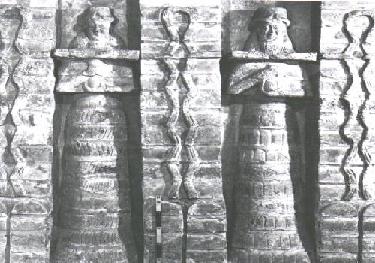Kassite Period (1595-1155)
 |
| Outer wall of the Inanna Temple at Uruk |
This period can be divided into two sub-periods: The Dark Ages (1595-1375) and the Later Kassite (1375-1155) . The Dark Ages are nearly devoid of historical records other than the names of the monarchs. After 1375, the records are more numerous and we have fairly accurate regal dates.
The Hittites were unable to hold on to Babylon after they sacked it because of the great distance, so they abandoned it, leaving a power vacuum. In swept the Kassites, an Iranian tribe and the rulers of Mari. The Kassites were an indigenous Iranian tribe from the central Zagros region south of Hamadan. They were organized into a nation of warriors by an Aryan aristocracy. They eventually took control of all of Sumer and Akkad. They had actually been infiltrating Mesopotamia since the 17th century. Ironically, it was the Kassites, a people regarded as inferior and barbaric who took the steps necessary to repair the damages to the land. They gradually turned Babylonia into a prosperous land. They also restored order and peace and ruled like good Mesopotamian Monarchs. The Kassite kings ruled a unified Mesopotamia longer than any other dynasty and Babylon became the political and cultural center of the ancient world under them. One of the reasons for their long reign was their conservatism. For the most part they did not engage in expansionist wars and they readily embraced the Babylonian culture. They called their Kingdom Kar-Duniash. The dates of the reigns, and even the order, of the kings is open to question, at least until 1375.
Babylon
Kassite Dynasty (3rd Dynasty)
Agum II Kakrime (c.1595-1545)-King of Mari. He conquered Babylonia when the Hittites withdrew.
Burnaburiash I (c.1545-1500)-He signed a peace treaty with Puzur-Ashur III of Assyria and established the border at the Samarra area.
Kashtiliash III (c.1500-1470)
Ulamburiash (c.1470-1465)
Agum III (c.1465-1445)-He conquered the Sealand and re-united the two lands of Mesopotamia once again.
Kadashman-Harbe I (c.1445-1440)
Karaindash (c.1440-1430)-A new treaty similar to the previous one was signed with Assyria. He built a new temple to Inanna in Uruk.
Kurigalzu I (c.1430-1380)-He was an enthusiastic builder, restoring Ur, which had been destroyed in the conquest of the Sealand. He also built the new royal residence, the city of Dur- Kurigalzu near Babylon. The temples of the city were dedicated to Enlil, Ninli and Ninurta. The presence of Sumerian gods in a Kassite city attests to the degree of assimilation that had taken place. He also built public projects in Uruk and Eridu.
Kadashman-Enlil I (c.1380-1359)-Either he or Burnaburiash II conquered Arrapha (Kirkuk).
Burnaburiash II (1359-1333)-He called himself the "Brother of the Pharaoh" and had excellent relations with Akhenaton.
Karahardash (1333)-Son of Burnaburiash. He was assassinated and a short civil war followed. He was the grandson of Ashur-Uballit of Assyria through his mother, the wife of Burnaburiash and some may have feared an Assyrian influence.
Nazibugash (1333)-He was overthrown by Ashur-Ubbalit of Assyria who intervened upon the death of his grandson.
Kurigalzu II (1332-1308)-Son of Burnaburiash II. He was installed by Assyria, but shortly he attacked them. They eventually made peace. He attacked and defeated Hurpatila, King of Elam and occupied it for at least part of his reign.
Nazimaruttash (1308-1282)-He warred with Assyria.
Kadashman-Turgu (1282-1264)-He warred with Assyria. He and his son had good relations with the Hittite king Hattushilus.
Kadashman-Enlil II (1264-1255)-Son of Kadashman-Turgu.
Kudur-Enlil (1255-1246)
Shagarakti-Shuriash (1246-1233)
Kashtiliash IV (1233-1225)-He fought unsuccessfully against the Elamites. Tukulti-Ninurta I of Assyria captured Babylon, overthrew Kashtiliash and installed a puppet to rule in his name.
Tukulti-Ninurta (1225)-The Assyrian king. Babylon's walls were destroyed and Marduk's temple plundered. He quickly installed a puppet governor and returned to Assyria.
Enlil-Nadin-Shumi (1225-1224)-Assyrian governor.
Kadashman-Harbe II (1224-1223)-Assyrian governor.
Adad-Shuma-Iddina (1222-1217)-Assyrian governor. During this period the Elamites attacked and raided as far as Nippur. Finally the people revolted and restored native rule.
Adad-Shuma-Usur (1217-1187)-Son of Kashtiliash IV.
Melishipak (1187-1172)
Marduk-Apal-Iddina I (Merodach-Baladan) (1172-1159)-Son of Melishipak. He is sometimes called Merodach-Baladan, since Marduk-Apal-Iddina II is called that in the Old Testament.
Zababa-Shuma-Iddina (1159-1158)-He fought the Elamites in the south (see below), possibly dying in the war.
Enlil-Nadin-Ahhe (Enlil-Shuma-Usur) (1157-1155)-His name is sometimes translated as Enlil- Shuma-Usur. In 1159, King Shutruk-Nahhunte of Elam left Susa with a vast army and plundered Sumer as never before. Monuments such as the Code of Hammurabi and Naram-Sin's Stele were carried away forever. After plundering Sumer, they marched north and laid siege to Babylon. Shutruk-Nahhunte appointed his son Kutir-Nahhunte as governor and returned to Susa. Enlil- Nadin-Ahhe fought hard, but Babylon fell in 1157. Its possible that Enlil-Nadin-Ahhe fought for two or three years after the fall of Babylon (to 1155). The statue of Marduk was carried away to Susa. The Elamites either withdrew or they were expelled the next year.

